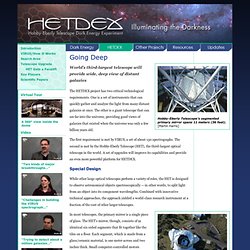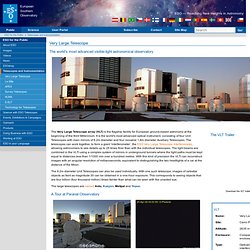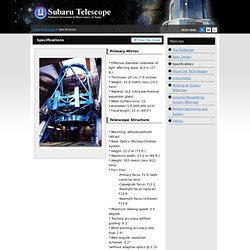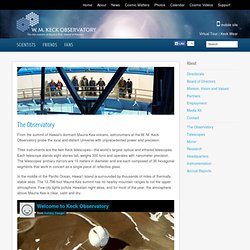

Hobby-Eberly Telescope Upgrade - HETDEX. Hobby-Eberly Telescope’s segmented primary mirror spans 11 meters (36 feet).

[Martin Harris] World’s third-largest telescope will provide wide, deep view of distant galaxies The HETDEX project has two critical technological requirements. One is a set of instruments that can quickly gather and analyze the light from many distant galaxies at once. The other is a giant telescope that can see far into the universe, providing good views of galaxies that existed when the universe was only a few billion years old. The first requirement is met by VIRUS, a set of about 150 spectrographs. Special Design While other large optical telescopes perform a variety of roles, the HET is designed to observe astronomical objects spectroscopically — in other words, to split light from an object into its component wavelengths. An aerial view of Hobby-Eberly Telescope, with blue sky reflecting off its primary mirror. In most telescopes, the primary mirror is a single piece of glass. Upgrading for the Future.
The Very Large Telescope. <div class="box3"><b>Did you know?

</b> The smallest detail distinguishable with the VLT's adaptive optics system is smaller than the size of a DVD on the International Space Station, as seen from the ground (about 50 milliarcseconds). </div> Did you know? The smallest detail distinguishable with the VLT's adaptive optics system is smaller than the size of a DVD on the International Space Station, as seen from the ground (about 50 milliarcseconds). Did you know? Specifications - Subaru Telescope.
Print This Article Photos of Subaru Telescope and Enclosure Subaru's Four Foci Click here for the image without labels.

Instruments 1) Prime Focus Instruments designed to take advantage of the large field of view at prime focus Fiber Multi-Object Spectrograph (FMOS) Subaru Prime Focus Camera (Suprime-Cam) 2) Nasmyth Focus (Optical) Heavy instruments such as high resolution spectrographs High Dispersion Spectrograph (HDS) 3) Nasmyth Focus (Infrared) Infrared Camera and Spectrograph (IRCS) 188-Element Adaptive Optics (AO) 4) Cassegrain Focus A variety of instruments tailored to a wide range of research goals Multi-Object Infrared Camera and Spectrograph (MOIRCS) Faint Object Camera and Spectrograph (FOCAS) Cooled Mid-Infrared Camera and Spectrograph (COMICS) Former Generation Instruments OH-Airglow Suppressor/Cooled Infrared Spectrograph and Camera for OHS (OHS / CISCO) Subaru Adaptive Optics System (AO) Coronagraphic Imager with Adaptive Optics (CIAO)
Large Binocular Telescope Observatory. Gran Telescopio CANARIAS - Inicio. Home: SALT. W. M. Keck Observatory. From the summit of Hawaii’s dormant Mauna Kea volcano, astronomers at the W.

M. Keck Observatory probe the local and distant Universe with unprecedented power and precision. Their instruments are the twin Keck telescopes—the world’s largest optical and infrared telescopes. Each telescope stands eight stories tall, weighs 300 tons and operates with nanometer precision. The telescopes’ primary mirrors are 10 meters in diameter and are each composed of 36 hexagonal segments that work in concert as a single piece of reflective glass. In the middle of the Pacific Ocean, Hawai’i Island is surrounded by thousands of miles of thermally stable seas.
Because of the large size of the 10-meter primary mirrors, the Keck telescopes offer the greatest potential sensitivity and clarity available in astronomy. AO corrects for the image distortions by measuring and then correcting for the atmospheric turbulence using a deformable mirror that changes shape 2,000 times per second. The W. The W.